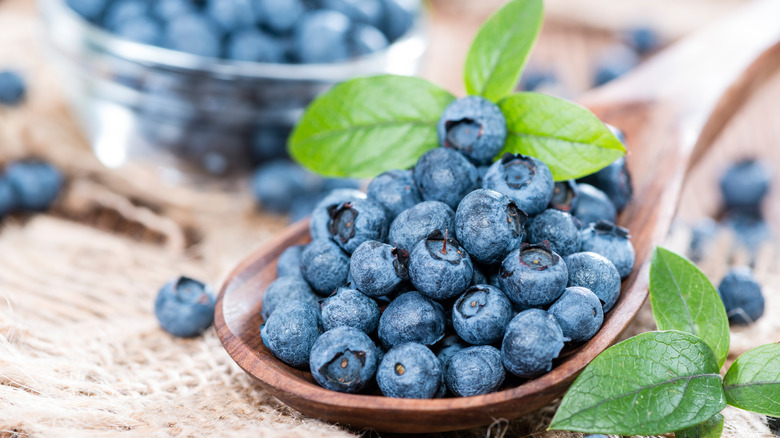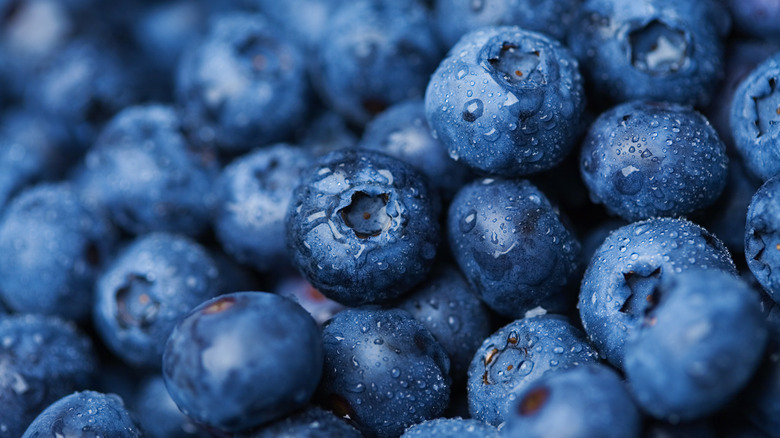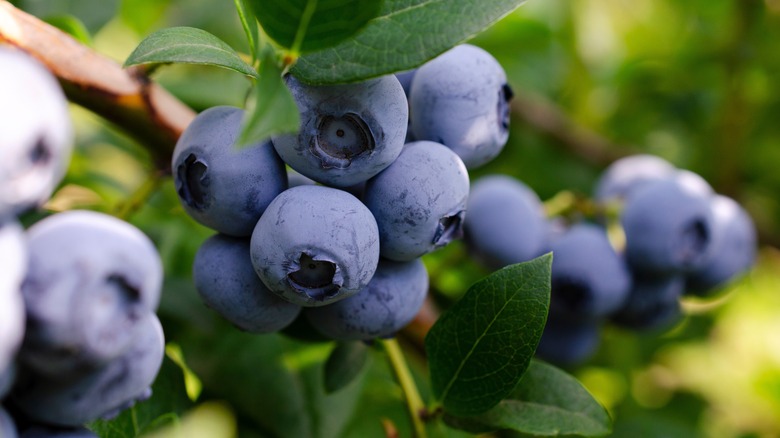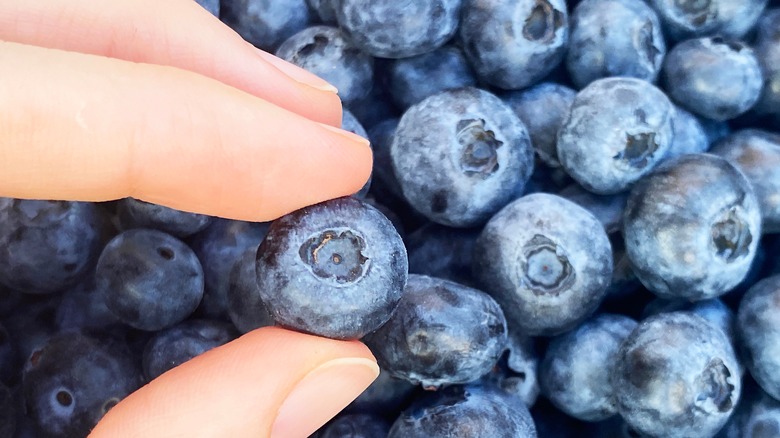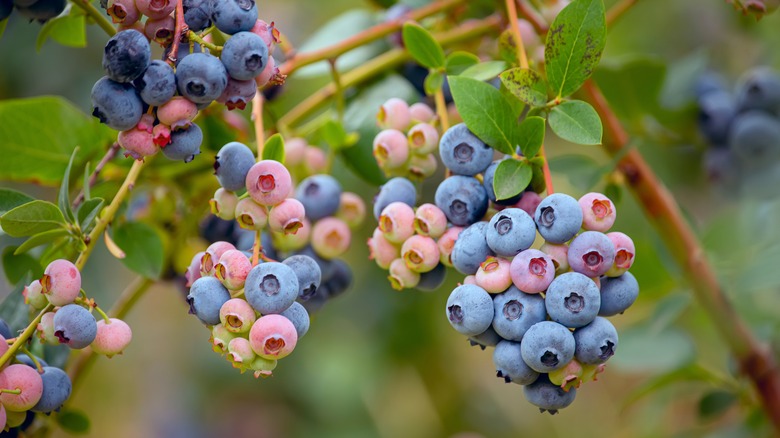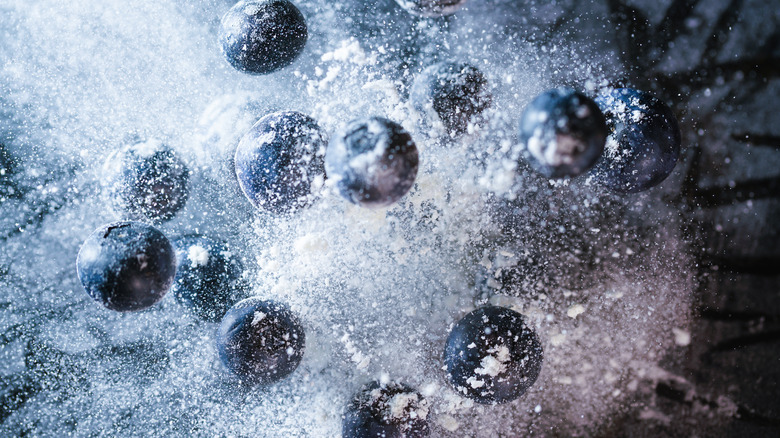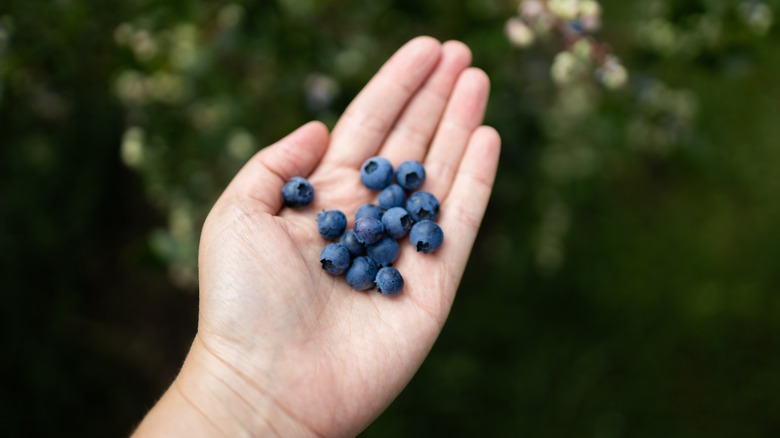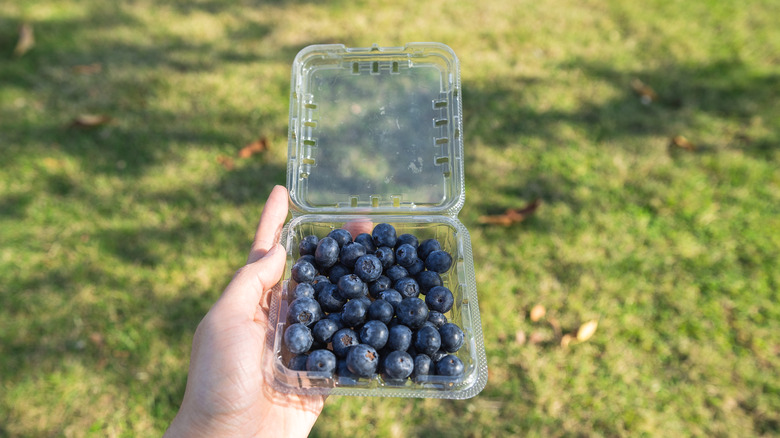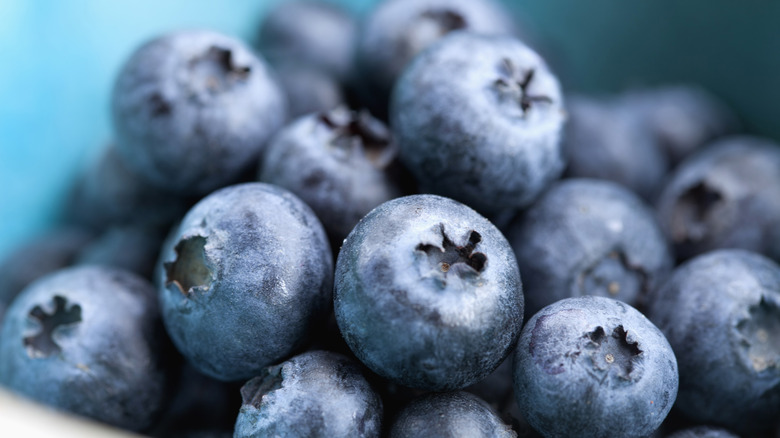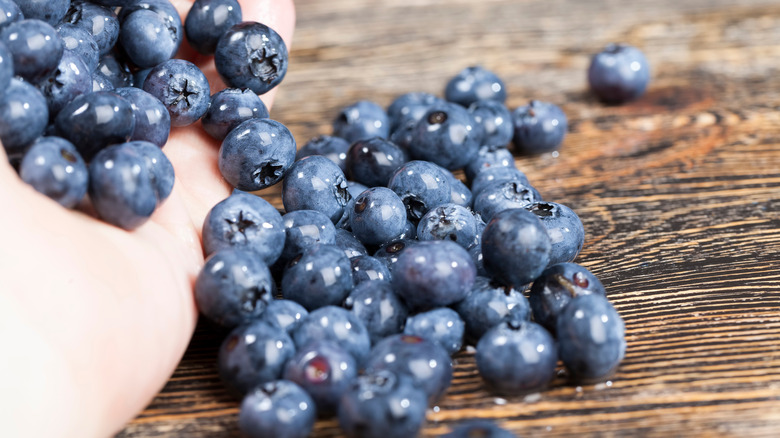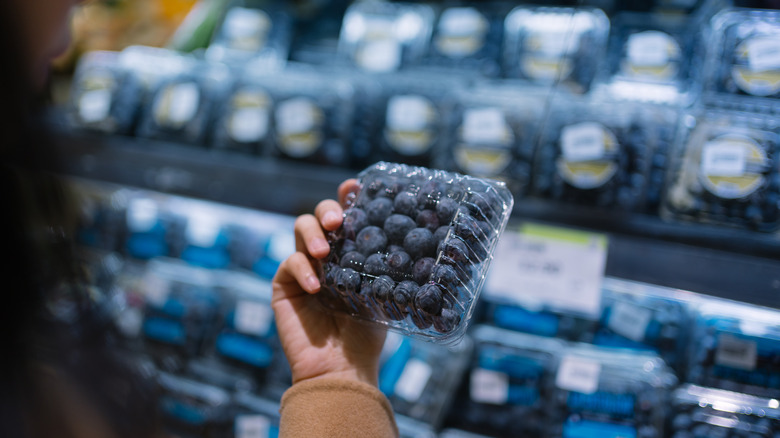A Blueberry Breeder Reveals 11 Mistakes Everyone Makes When Buying Blueberries
When the weather turns warm, fruit lovers' thoughts turn to blueberries. While available year-round, the tasty little berries are in season in North America between April and September –that's when you'll start to notice fresh, locally grown blueberries for sale. And if you're lucky enough to have a nearby farmer's market or U-pick farm with berries you enjoy, take advantage of it. If you can't eat them all at once, they freeze beautifully, and a nice stash of them will allow you to enjoy blueberry muffins and hot, fluffy blueberry pancakes well after your favorite farm closes for the season.
Whether you enjoy eating them out of hand or adding them to salads or colorful desserts such as this summery blueberry beer cake, you can feel good knowing blueberries are, well, good for you. They're an excellent source of vitamin C and vitamin K, and are rich in flavonoids, which can reduce the risk of heart disease and some types of cancer, notes WebMD. Best of all, they taste great — provided you choose the right ones. We asked Todd Gray, James Beard Award-nominated chef at Equinox in Washington, D.C., and Paul Lyrene, award-winning blueberry breeder, for their tips on buying the sweetest and most flavorful blueberries — and, you know, all those big mistakes to avoid.
Buying fresh blueberries out of season
With today's global supply chain, many of us can buy almost any fruit or vegetable at any time of year. Because of this, few consumers think twice about buying fall fruit such as apples in July or spring and summer fruit (strawberries and watermelon, for instance) in December. While this offers cooks and eaters many more choices than were historically available, this doesn't mean you're getting the best quality — common sense tells us that fruit grown in less-than-optimal conditions or shipped from halfway around the world will not be the same as its fresh, locally grown counterparts.
Blueberries are a case in point. The experts know that waiting for blueberry season is well worth the trouble. "We only use them [blueberries] (for the most part) when they're in season," says Todd Gray, chef at Equinox in Washington, D.C. In North America, summer is the time to enjoy the best blueberries.
"July and August is when they are likely to be best because there are large quantities being harvested in Michigan and British Columbia Canada," says Paul Lyrene, blueberry breeder and emeritus professor of horticultural sciences at the University of Florida. "Usually berries are best and freshest when the price is lowest."
Believing bigger is always better
When it comes to blueberries, size matters — but not in the way you might think. While popular culture has conditioned us to seek out the biggest, blingiest version of everything — especially food — bigger isn't always better. So while new varieties of conspicuously large blueberries have started showing up in stores in recent years, they're not always the tastiest option. "They seem to be getting bigger with all the GMO-type breeding — these I avoid," chef Todd Gray says. "We prefer wild Maine blueberries — which are smaller but super flavorful."
Paul Lyrene, blueberry breeder, agrees. "Jumbo-size blueberries are available at high price in some months but these are not necessarily above average in flavor or texture," he says. Lyrene also warns against too-small berries. "Ideally, the berries should be medium to large." This is especially important if you're picking your own. If you're picking from a plant laden with berries, he advises, "Get the largest ones."
Avoiding berries with a white coating
Some shoppers shy away from blueberries if they see a whitish film on their skins, believing that good-quality blueberries should be pure blue. This is a mistake that can keep you from enjoying truly fresh berries: That film is a natural and expected part of the fruit. "[The] color of blueberry has two determinants: anthocyanin, which make the skin black, and a surface wax, which makes fresh blueberries powdery blue," explains Paul Lyrene, blueberry specialist and emeritus professor of horticultural sciences at the University of Florida. "The latter is usually removed during harvest, packing, and shipping so most berries you see in the market are rather dark."
This may be why many people find that white coating disturbing when they encounter it. But true blueberry fans embrace this visual quirk, rather than shy away from it. "Believe it or not, the white powdery substance is a natural part of a healthy blueberry — it is a bloom that protects them — so don't be put off by that!" says Todd Gray, James Beard Award-nominated chef at Equinox in Washington, D.C. "It's not pesticides — which I thought it was till I learned about bloom."
Buying unripe blueberries to ripen at home
When you buy bananas, peaches, or avocados from a supermarket, you know you'll most likely have to wait a few days before you eat them. There's a reason these fruit (along with other stone fruit, as well as tomatoes) are almost always hard and unripe when you find them in a store: Soft, ripe fruit is too fragile to survive the journey from farm to store to consumer, so processors harvest the fruit when it's just mature enough to ripen on its own once it gets to its final destination.
Not all types of fruit, however, continue to ripen after harvest. The blueberries you pick or buy are the blueberries you're going to eat — they won't get any sweeter or better. "Pick only the ripe ones!" Todd Gray, chef at Equinox, advises. "Blueberries, unlike other berries, do not continue to ripen once picked." The best way to tell if a blueberry is ripe is by its color: It should be solidly blue. "Avoid pink or white berries," Gray explains. And while softness is a sign of ripeness in stone fruit, this is not the case for blueberries — even the ripest ones should be firm.
Ignoring frozen blueberries
In a perfect world, we'd eat nothing but tree-ripe, just-picked fruit. But sometimes the things we really crave — such as freshly picked local blueberries — are not available. This is when many of us turn to whatever fresh blueberries are available at the supermarket. This is a common mistake. Instead, your best option is to opt for good-quality frozen berries.
So why not fresh, non-local berries? Paul Lyrene, blueberry expert, says these berries may have travelled a long distance to get to your supermarket. "[Blueberries] are available from the U.S. growers from March through September and from Peru, Chile, etc. as imports the rest of the year," he says. This means that besides being a bit worse for wear, these berries will also be more expensive. So when he can't get fresh blueberries from local sources, Lyrene prefers frozen wild blueberries from Maine or the Canadian maritime provinces.
Chef Todd Gray also likes frozen wild blueberries. "We use frozen for certain baking applications," he says, "but there are proven to be more nutrients in frozen because they are picked at the height of freshness and flash frozen, which can preserve much of what is lost over time for fresh berries. We use the frozen on our granola at home."
Forgetting to check berries for bruises and punctures
For many of us, fresh blueberries are such a treat that we're not terribly critical when we get our hands on them. Whether we're picking our own at a U-pick farm or buying boxes of them at the store, we happily grab the first ones we see, thoughts of freshly baked blueberry muffins or a blueberry limoncello drizzle cake dancing in our heads. But while blueberries are naturally firmer and less fragile than many other berries, they are still vulnerable to damage — so don't forget to check your blueberries before you buy.
So besides inspecting your berries to ensure they're ripe, look out for fruit with signs of structural damage. "Be sure there are no broken skins and the color is almost black or very dark blue," says Todd Gray, chef at Equinox. And if you're buying packaged berries, look for clamshell boxes with ventilation holes – these help protect berries from being crushed or broken and reduce your chances of bringing home blueberry puree instead of a box of perfectly intact berries.
Not checking the package before buying
Packaged foods can give us a false sense of security. We tend to assume that every box of cereal or box of fruit we buy will be safe and appetizing because it almost always is. For this reason, many of us grab the closest package and toss it into our grocery cart without looking. When you're shopping for blueberries, however, this can be a mistake. To ensure you get the tastiest and highest quality berries available to you, it pays to inspect the boxes before you choose the ones you'll take home.
"You can judge in the clamshell, turn it upside down and make sure there are not shriveled, green, or moldy berries on the bottom," suggests Paul Lyrene, award-winning blueberry breeder and emeritus professor of horticultural sciences at the University of Florida. "The package should show the country of origin and often the state where they came from." You can also inspect packaged blueberries with your ears as well as your eyes: Give the container a light shake, and if the berries rattle (a bit like ball bearings would), this means they have the appetizing firmness you want.
Going to an overcrowded U-pick farm
Picking your own fresh blueberries is probably the most satisfying way to obtain them, short of growing them yourself. It's a relaxing way to spend an hour or two during the summer, and a great way to keep your kids entertained while they absorb a useful lesson about where food comes from. But if the goal of your visit to a U-pick blueberry farm is to acquire the best possible berries, you need more than a bucket and a ready pair of hands: You need strategy.
According to Paul Lyrene, blueberry breeder, your chances of scoring great berries are better at quieter farms. "If there are more people picking than there are berries available at a farm, you are normally picking immature berries or berries that just turned blue," he says. "Best to go when there are lots of ripe berries hanging on the plants — more berries than customers picking." He added that blueberries taste their best if they stay on the plant for seven to 10 days after they turn blue — and your odds of encountering these increase when you have less competition.
Buying frozen rabbiteye berries
Experts agree that frozen blueberries can be a better option than fresh, especially when local berries are out of season or otherwise unavailable. However, not all frozen blueberries are alike. Chef Todd Gray and blueberry breeder Paul Lyrene recommend frozen wild Maine blueberries as a good alternative to fresh. Lyrene notes, however, that rabbiteye blueberries tend to be disappointing when frozen. "They are likely to be seedy with tough skins," he warns.
So if rabbiteyes are so bad, why are they commercially grown at all? Lyrene explains they're a native species that occurs naturally in north Florida and can thrive in conditions where highbush blueberries (the most commonly sold commercial type) cannot. Rabbiteye blueberries are also easier to grow than highbush berries. And when fresh, the berries produced by rabbiteye plants can be plenty tasty. But because of their natural ripening schedule and market pressures, producers don't invest a lot of care into preparing them for freezing. "The best rabbiteye varieties properly grown in the southeast produce berries of very high quality, but because they ripen at a time when market prices are low, they are not grown so carefully as highbush and are harvested with machines, which lowers berry quality," Lyrene explained.
Settling for canned berries
Besides fresh and frozen blueberries, you've probably seen canned ones at your supermarket. While they're convenient and nice to keep in the pantry if you want blueberries around but won't have time to cook with them right away, they're not the best choice if you want to replicate the taste and mouthfeel of fresh berries. "Canned blueberries have too much added sugar," blueberry expert Paul Lyrene says.
And because they're already cooked and sweetened, canned blueberries also have a different, softer texture than fresh or even thawed frozen berries. This makes them a poor choice for preparations in which the look and texture of individual berries matters, such as salads. If canned blueberries are all you have available, the best use for them would be in preparations in which the fruit will end up sweet and a bit mushy by design, such as in smoothies or in this sour cream with blueberry swirl ice cream. So if fresh blueberries are out of season, the closest (and most versatile) alternative is good-quality frozen fruit.
Not trying before buying
Most of us have experienced the disappointment of buying nice-looking fresh fruit only to find it flavorless and dull. This is especially frustrating when you've purchased a large quantity of fruit for a special occasion — such as a large bag of peaches for a homemade pie. Don't let this happen to you when you shop for blueberries. Instead, award-winning blueberry breeder Paul Lyrene advises you try them before you commit to investing in a large quantity.
"Buy a small packet of fresh blueberries. Pay for them. Walk outside the store and eat them," he says. "If they are really good, go back in the store and buy 10 more packs. Store them in your home refrigerator. They should keep two to four weeks." Lyrene also urges sampling the options when you're picking blueberries at a farm to see which best suit your tastes. "If there are multiple varieties on the same farm, sample a few from each variety to get the best."

